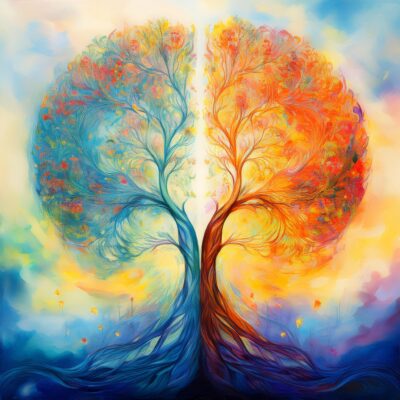 This is a journey of individuation and sacred union. The Twin Flame Journey is often described as a profound and transformative connection—one that mirrors both the light and shadow aspects of the self. While Carl Jung never explicitly wrote about twin flames, his theories on the anima and animus, individuation, and the hieros gamos (sacred union) offer a compelling framework for understanding the psychological and spiritual depth of this connection. In many ways, the twin flame dynamic serves as a living manifestation of Jung’s ideas, pushing each partner toward self-realization and wholeness.
This is a journey of individuation and sacred union. The Twin Flame Journey is often described as a profound and transformative connection—one that mirrors both the light and shadow aspects of the self. While Carl Jung never explicitly wrote about twin flames, his theories on the anima and animus, individuation, and the hieros gamos (sacred union) offer a compelling framework for understanding the psychological and spiritual depth of this connection. In many ways, the twin flame dynamic serves as a living manifestation of Jung’s ideas, pushing each partner toward self-realization and wholeness.
 The Audio Take — a fast listen with new angles on the topic HERE.
The Audio Take — a fast listen with new angles on the topic HERE.
Anima, Animus, and the Twin Flame Mirror
Jung proposed that every individual carries both masculine and feminine energies within them. He described these inner counterparts as the anima and animus—terms historically used to refer to the unconscious feminine and masculine aspects of a person. While Jung originally framed these concepts in relation to binary gender roles, they can be understood more broadly as archetypal energies that influence an individual’s self-perception and relationships. Rather than being tied to a specific gender, these aspects reflect the dynamic interplay of traits within each person, shaping both their inner world and their connections with others.
In the twin flame journey, each partner often embodies the aspects of the other’s unconscious material, acting as a mirror for growth and self-discovery. The divine masculine and divine feminine energies that twin flames frequently discuss parallel Jung’s anima and animus. Through their interactions, twin flames surface each other’s deepest wounds, patterns, and unresolved conflicts, compelling each partner to integrate the unacknowledged parts of their psyche. This process can feel like an intense push-and-pull—one partner may retreat just as the other reaches out, mirroring the natural resistance to facing one’s own shadow.
The Twin Flame as a Catalyst for Individuation
At the heart of Jungian psychology is the process of individuation—the journey toward becoming a whole, integrated self. This requires acknowledging and integrating the unconscious into conscious awareness. Twin flames, in many ways, accelerate this process by forcing each other to confront their fears, ego defenses, and unhealed wounds.
This dynamic often plays out in the rhythm of twin flame relationships: moments of deep connection followed by periods of separation. The push-and-pull, the “go away, hug me” cycle, reflects the internal struggle of individuation. One partner may long for reassurance, while the other resists providing it, knowing that true security must come from within. This echoes Jung’s understanding that psychological growth does not come from external validation but from deep inner work. When a twin says, “I can’t reassure you. This has to come from inside you,” they are, in essence, acting as a guide toward individuation.
Transcendence and the Sacred Union
Jung also explored the concept of the hieros gamos, or sacred marriage—the mystical union of opposites. In psychological terms, this represents the integration of the conscious and unconscious, the masculine and feminine, within an individual. While many twin flames seek reunion in the physical world, the deeper purpose of their connection is to reconcile duality within themselves. The relationship serves as a catalyst for this inner alchemy, pushing each partner to embody both their divine masculine and feminine aspects.
This perspective shifts the focus from external attachment to inner transformation. Twin flames are not about completing one another but about challenging each other to evolve. Unlike soulmates, who bring harmony and ease, twin flames ignite the friction necessary for deep psychological and spiritual growth. As Jung noted, true transformation often arises from tension, not comfort.
The Foundation is Laid: Surrendering Expectations
Over time, twin flames come to recognize that their connection defies conventional relationship models. Expectations must be suspended, allowing the relationship to unfold in its own divine rhythm. As one twin wisely puts it, “I am not going anywhere. I am always here. The foundation is laid.” This echoes the Jungian understanding that individuation is not about clinging to another but about integrating all aspects of the self, standing fully in one’s own being.
Twin flames, then, are not merely romantic partners but profound psychological mirrors. Their purpose is to awaken, challenge, and transform. Through their dynamic, each partner is called to embark on the ultimate journey—toward self-realization and the sacred union of the soul. The Twin Flame Journey is an opportunity to become sovereign and engage in the spiritual awakening that is calling.






